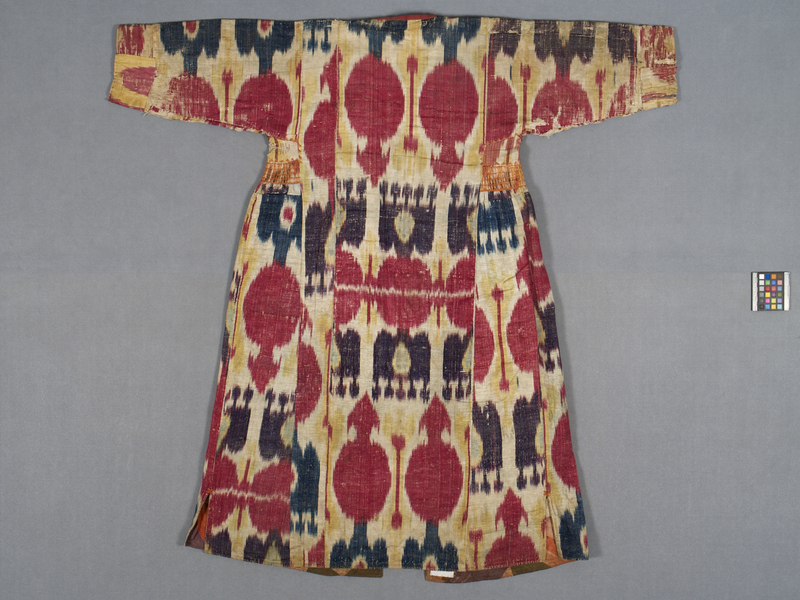Coat Item Number: 3231/14 from the MOA: University of British Columbia


Description
Woman’s full-length, A-line, quilted, colourful robe with long tapered sleeves; open at centre front from neck to hem with no closures; right and left centre fronts slightly overlap at hem; made of red, yellow, green and purple warp-ikat textile, silk warp, cotton weft. Gathers at the underarm are embellished with decorative stitches worked with orange thread. All edges are faced on the inside with bias strips of multi-coloured cotton textile. Lined with machine printed cotton textile with red, green and brown floral motifs on an off-white background. Back neck edge bound with dark red twill tape. Light layer of cotton batting between the outer textile and the lining.
History Of Use
Ikat robes were worn by men, women and children of various cultures. Women’s robes incorporate extra fullness under the armholes, for wearing ease, and the front opening is typically wide at the chest area, to show the lavish jewelry that women often wore. Robes were worn on top of a shirt, tunic or dress and with wide drawstring pants. Several robes may have been worn at once, layered one over another, to display rank and/or wealth. The colourful printed cotton textiles which were typically used to line robes were manufactured in Russia for the Central Asian market, as was the striped bias-cut cotton textile that was used as facings on all the edges (called the lapse). Following the Russian Revolution, the workshops that made ikat robes like this one, which had been organized around family and social networks, were disbanded by the Soviet government, replaced by collective practices in factories. Eventually the making and wearing of ikat robes disappeared.
Narrative
Joanna Staniszkis purchased this robe at a second-hand shop in the Kerrisdale district of Vancouver.
Specific Techniques
Warp-faced ikat technique.
Iconographic Meaning
This robe does not have decorative edging on all outside edges. This is unusual because the decorative braid or embroidery was believed to be an essential part of the garment, as it prevented evil spirits from infecting the wearer.
Item History
- Made in Uzbekistan before 1900
- Collected in Vancouver, British Columbia, Canada during 1991
- Owned by Joanna Staniszkis before March 20, 2017
- Received from Joanna Staniszkis (Donor) on March 20, 2017
What
- Name
- Coat
- Identification Number
- 3231/14
- Type of Item
- coat
- Material
- silk fibre, cotton fibre and dye
- Manufacturing Technique
- warp-faced ikat
- Overall
- height 120.0 cm, width 120.5 cm
Who
- Culture
- Uzbek
- Previous Owner
- Joanna Staniszkis
- Received from
- Joanna Staniszkis (Donor)
Where
- Holding Institution
- MOA: University of British Columbia
- Made in
- Uzbekistan
- Collected in
- Vancouver, British Columbia, Canada
When
- Creation Date
- before 1900
- Collection Date
- during 1991
- Ownership Date
- before March 20, 2017
- Acquisition Date
- on March 20, 2017
Other
- Item Classes
- textiles
- Condition
- fair
- Accession Number
- 3231/0014